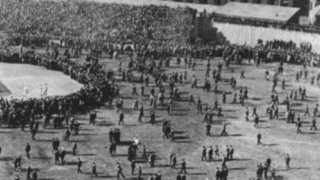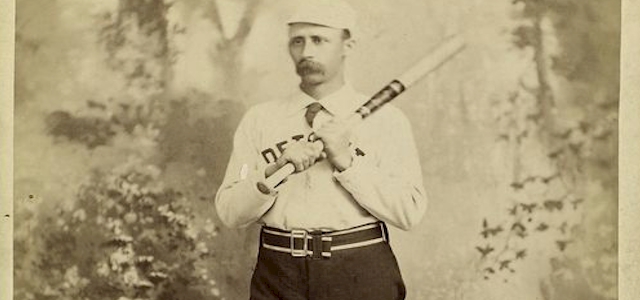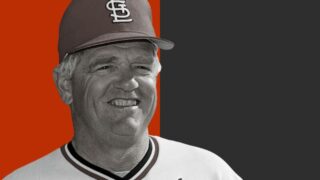In a playing career spanning two decades in the 19th century, Deacon White was a fine hitter and defensive player at both catcher and third base. He won two batting titles, one in the National Association, the other in the National League. When he retired he held many of the all-time marks in the baseball record book, though they were eclipsed in the decades that followed.
White is credited with collecting the first hit in professional major league baseball, though that may not be completely accurate. He was however, one of the most respected and famous players in the National Association and subsequent National League. His membership in the NL lent a respectability to the fledgling league.
In his early days, White was a great catcher, playing the position several feet behind home plate, as was the custom at that time. Later, White transitioned to third base, where his great throwing arm continued to be an asset.
Throughout his career, White played on some of the most successful and powerful teams of the 19th century. When he played for the Buffalo Bisons he was part of baseball’s “Bifg Four” along with teammates Dan Brouthers, Jack Rowe, and Hardy Richardson. White was a key part of the 1887 Detroit Wolverines, who also won a NL flag.
As a batter, White hit for a high average and drove the balls to the gaps. He led his league in runs batted in three times, and was consistently among leaders in slugging and on-base percentage.
White was a devout man and a serious man who was respected by nearly everyone he came in touch with. As a result he had great influence on events in the 1880s when professional baseball was trying to establish a set of rules and a structure. White was instrumental in forming the Players League, which helped in a small way to bring more equitable pay and benefits to players.
A thorough history of the early days of organized baseball would be incomplete without an analysis of the career and contributions of White. For that reason, as well as his obvious talents with a bat and in the field, it’s difficult to understand why White has not been selected to the Hall of Fame. He has been on various veterans or old-timers ballots in the past, but voters have failed to recognize his deserving status.
Of all of the candidates on the Pre-Integration Era ballot, White is most deserving. He was a great player, and a significant figure in the history of baseball in the 19th century.





Enjoyed your article, but I respectfully disagree. I’d put White third on this ballot. Bill Dahlen is head and shoulders the most deserving candidate for the Hall among this group of nominees, followed by Tony Mullane, and then White third with Wes Ferrell fourth. I’d also put Sherry Magee, Cupid Childs, Smoky Joe Wood, Jack Quinn, Tommy Bridges and Larry Doyle above White. Perhaps even Del Pratt. Hopefully the Hall will take a comprehensive look at this entire era in a few years, much like they did with the Negro Leagues five or six years ago.
I think Del Pratt is an interesting candidate, also Larry Doyle. Not sure about Bridges or Quinn, but Sherry Magee deserves attention. I have written extensively elsewhere that I think Lefty O’Doul deserves immediate induction.
Deacon White’s case for the Hall of Fame isn’t in his numbers, which by the Jaffe JAWS system clearly show he is way below the line. After all, he played in the 1870s and 1888s, when 9 balls were a walk, four strikes were an out, and pitchers threw underhanded. you couldn’t really call that baseball.
Rather, Deacon White, like Marvin Miller, was a pioneer of breaking the reserve clause in baseball. He with Cap Anson jumped his contract from the National Ass’n to the National League in 1875; was bought by Detroit from Buffalo as part of the Big Four, prompting his comment, “No Man can buy my carcass unless I get one half [the money paid]..” Finally Deacon White was one of the prime organizers with Monte Ward of the Players League revolt of 1890, and he with a partner owned and operated the Buffalo franchise of the Players League for the 1890 season.
White was pro union, pro players and anti owners all his life. He was Marvin Miller before there was Marvin Miller. During the 1880s & 1890s a number of test cases were brought by Monte Ward and Deacon White’s associates in the courts, nearly all of which demonstrated that there was, in fact, no “reserve clause” and that players were free to jump contracts at the end of the term.
It is primarily for his contributions to the labor freedom of the players, and for being years ahead of his time in this respect, that we should honor Deacon White with a place in the Hall of Fame.
This drivel about his piety and sanctity is silly. The war between the players and the owners was no less in the 1800s than it is today, and Deacon White was a ferocious warrior for the labor rights of the players. He should be remembered for this as we induct him into the HOF.
The next person logically to be honored would of course be Marvin Miller, who stands on the shoulders of men like Deacon White and Jackie Robinson.
–Art Kyriazis
Very excellent points. A few I should have included in the article. At least we can both agree that it’s about time that Deacon got his due.